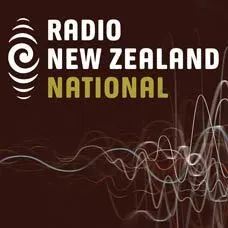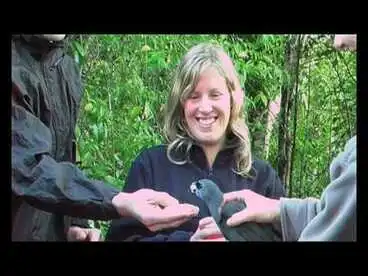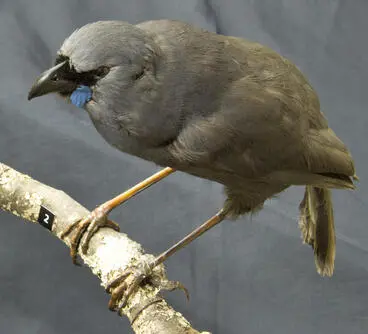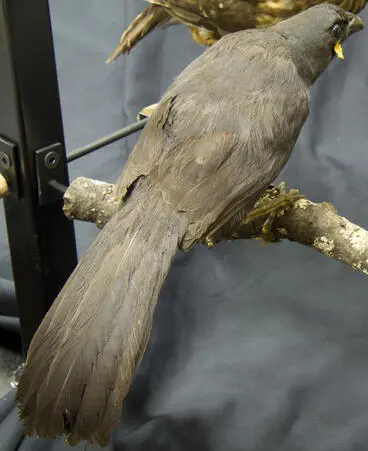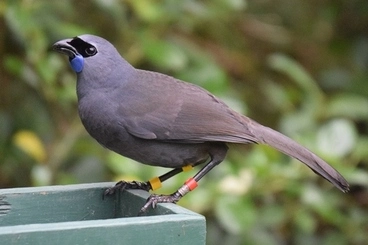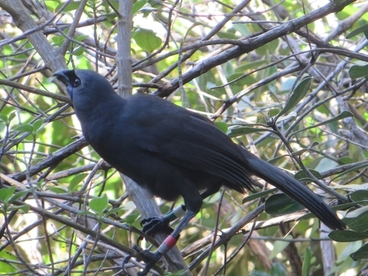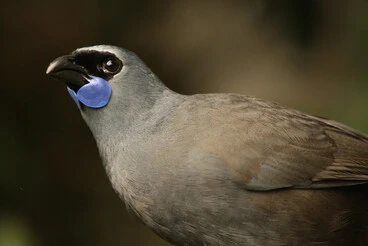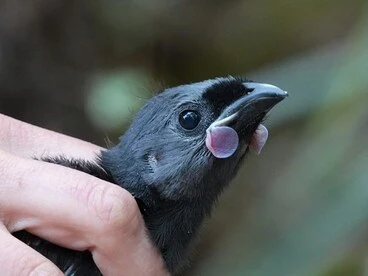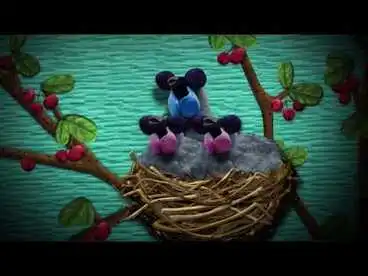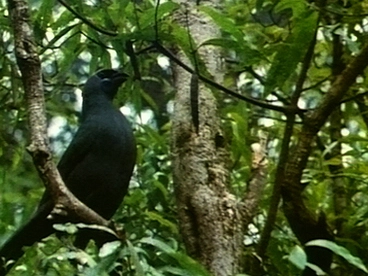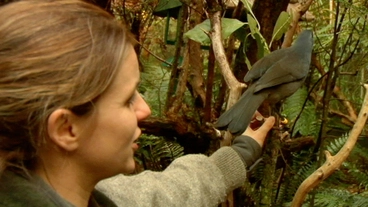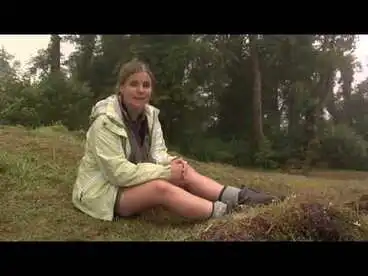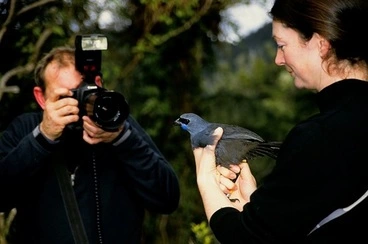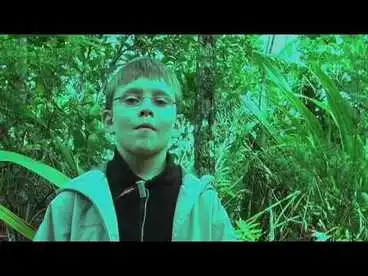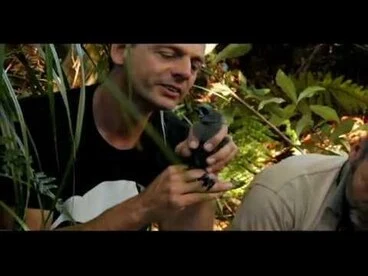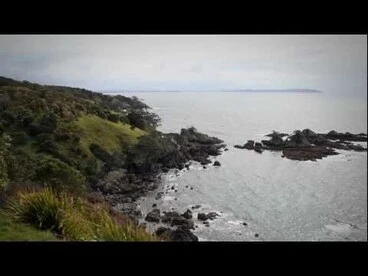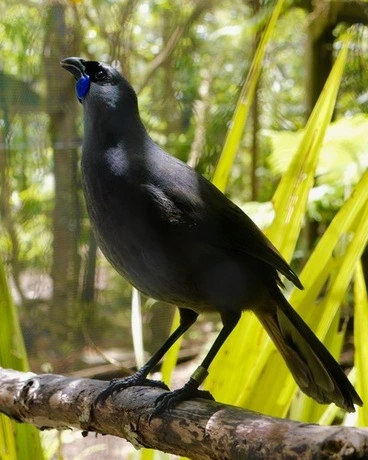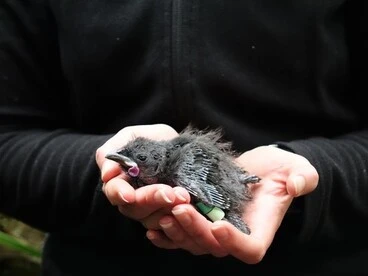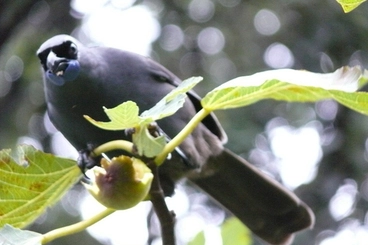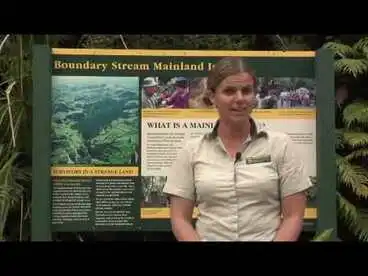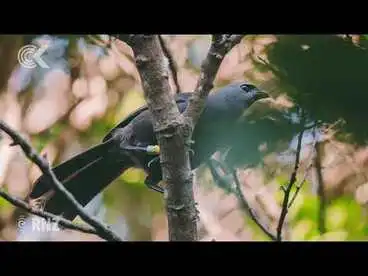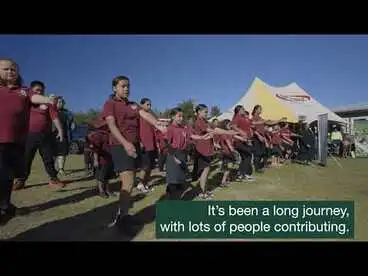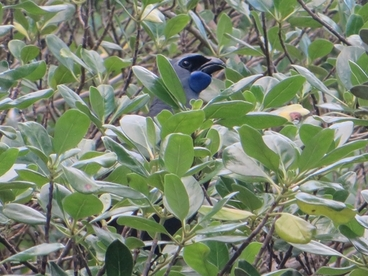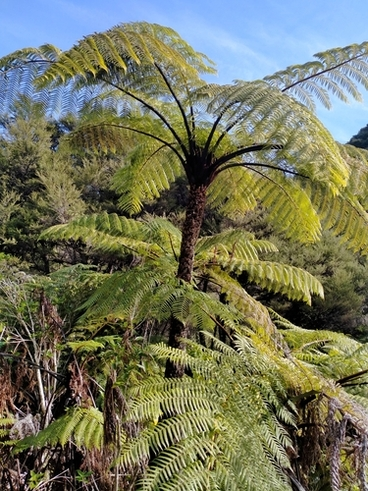Saving the kōkako
A DigitalNZ Story by Zokoroa
A celebration of the kōkako which is an endangered native bird living in NZ forests.
Kōkako, Wattlebirds, birds, native birds, conservation, endangered, extinct
A memorable moment was an intermediate school trip to see the kōkako. We awakened early in the morning at our Waitomo camp and set off on foot through the native bush to catch sight of the kōkako. We spotted one foraging in the tree-top branches - saw its blue wattles and heard its distinctive sound. (Listen to DoC: Kōkako song.) With numbers declining over the decades due to deforestation and predators, conservation projects have been reintroducing the kōkako to various locations in the North Island and outlying islands. By March 2021, the number of breeding pairs had increased to 2000 from 330 in 1999.
"In Māori myth, the kōkako filled its wattles with water and brought it to Maui as he fought the sun. Maui rewarded the bird by making its legs long and slender, enabling it to bound through the forest with ease." (Extract from DoC.)
Crowned Forest & Bird’s 2016 Bird of the Year
The blue-wattled crow received 3,614 votes which was more than a thousand votes ahead of its nearest rival, the kea.
Radio New Zealand
Māori traditions about kōkako
Ngāi Tahu leader Sir Tīpene O’Regan relates Māori traditions about the kōkako and other birds.
Manatū Taonga, the Ministry for Culture and Heritage
Kōkako were common in forests throughout NZ in the early 1900s
Manatū Taonga, the Ministry for Culture and Heritage
Deforestation & predation led to declining numbers
Predators include ship rats, possums, stoats and cats.
Manatū Taonga, the Ministry for Culture and Heritage
Predators - possum
A night-vision camera has captured a possum chasing a kōkako off her nest, and eating the eggs.
Manatū Taonga, the Ministry for Culture and Heritage
North Island kōkako: NATIONALLY INCREASING
In 2021, the conservation status of the North Island kōkako was reclassified from Threatened to Nationally increasing. For further information, see New Zealand Birds Online: North Island Kōkako
Small populations continue to exist & translocations to other sites have occurred since 1981
Areas where continued to exist: Waikato, Bay of Plenty, Te Urewera, South Auckland & Northland.
Forest and Bird
Conservation status since 2021: Nationally increasing
North Island kōkako population has increased from c.330 pairs in 1999 to over 2000 in March 2021 due to pest control.
Puke Ariki
South Island kōkako: DATA DEFICIENT
In 2013, the conservation status of the South Island kōkako was reclassified from Extinct to Data deficient. For further information, see New Zealand Birds Online: South Island Kōkako.
South Island kōkako (Callaeas cinerea)
A blue-grey body, a black mask & small, orange wattles that arise from the base of the bill and sit under the throat.
Manatū Taonga, the Ministry for Culture and Heritage
In 2008, the Dpt of Conservation had declared the South Island kōkako as being extinct
The last accepted sighting had been at Mt Aspiring National Park in 1967.
Radio New Zealand
In 2013, the conservation status was changed to: Data deficient
This led to the acceptance of a sighting from near Reefton on the West Coast of the South Island in 2007.
Puke Ariki
Characteristics
Physical appearance
Kōkako weigh 233 grams (male), 218 grams (female); are 38 cms long; have long legs & a long tail; & short, strong bill.
iNaturalist NZ — Mātaki Taiao
Branch hoppers
Reside in native forest & hop & leap around trees with their strong legs & small wingflaps.
iNaturalist NZ — Mātaki Taiao
Flight: Gliders
Are poor fliers - can glide down on their short wings, but are not so good at flying upwards.
Manatū Taonga, the Ministry for Culture and Heritage
Food
Kōkako mainly eat fruit and leaves and, less often, flowers, moss, buds, nectar and invertebrates.
Manatū Taonga, the Ministry for Culture and Heritage
Breeding age: 1-2 years
Lay 2-4 eggs during Nov-Feb in cup nests 3-25m high in trees & may raise 1 to 3 broods, after which they moult.
Manatū Taonga, the Ministry for Culture and Heritage
Incubation
The female incubates the eggs for c.18 days and nests for 27-42 days.
Manatū Taonga, the Ministry for Culture and Heritage
When young the wattles are a light pink colour which turns blue as an adult, 16 Nov 2018
iNaturalist NZ — Mātaki Taiao
Rearing young
Both parents feed the chicks who remain with them for up to a year.
Manatū Taonga, the Ministry for Culture and Heritage
Songbirds
"Rich, sonorous, sustained, organ-like notes are sung" (DoC). Males & females often duet.
Manatū Taonga, the Ministry for Culture and Heritage
Research on song & territorial behaviour
University of Waikato
CONSERVATION
Hear what Kimi Kōkako has to say
Kimi Kōkakō is in a flap and asks for help during Conservation Week, 2018.
Department of Conservation Te Papa Atawhai
With numbers declining over the decades due to deforestation and predators. conservation projects have been reintroducing the kōkako to various locations in New Zealand.
Find out more: New Zealand Birds Online: North Island Kokako, https://nzbirdsonline.org.nz/species/north-island-kokako
North Island:
Te Hauturu-ō-Toi / Little Barrier Island, early 1980s
Translocation of kōkako occurred in early 1980s. A 2013 survey estimated 422 pairs on Little Barrier Island.
University of Otago
Hūnua Ranges, 1994
Department of Conservation & Auckland Regional Council initiated the Hūnua Kōkako Project to reintroduce 25 kōkako.
Manatū Taonga, the Ministry for Culture and Heritage
Pūkaha National Wildlife Centre (Wairarapa), 1996
Kōkako were reintroduced (thought to have disappeared from Mount Bruce 40 years ago)
NZ On Screen
Kaharoa Forest, 1997
The Kaharoa Kōkako Trust was formed in 1997 when only 26 kōkako were in the Kaharoa Forest.
Radio New Zealand
Ōpōtiki, 2005
Mangaroa/Ohotu Trust had reintroduced kōkako, 2005.
Department of Conservation Te Papa Atawhai
Whirinaki (Bay of Pleny), Aug 2009
Thirty kōkako to be relocated iwith recorded birdsongs being played to help them settle
Radio New Zealand
Waitakere Ranges, 2010
Kōkako released in Waitakere Ranges.
Forest and Bird
Waitakere Ranges, 2011
Conservationists catch kōkako to reintroduce the birds into the Waitakere Ranges.
Radio New Zealand
Waitakere Ranges, 2011
Kōkako banding at Ark in the Park at Waitakere Ranges.
Forest and Bird
Tiritiri Matangi, c2012
Manatū Taonga, the Ministry for Culture and Heritage
Research on release of 20 kōkako, 2012
University of Waikato
Waitakere Ranges, 2013
The elusive kōkako Duncan has been found and released back into his home in the Waitakere Ranges.
Radio New Zealand
Paranihihi forest in Taranaki and the kōkako named Tamanui, 2014
Story about the kōkako, Tamanui, who was removed for safety from the forest in 1999 & had 22 offspring.
Radio New Zealand
Ark in the Park, 14 Dec 2016
One of two 16 day old kōkako nestlings which were banded.
iNaturalist NZ — Mātaki Taiao
Kapiti Island, 2016
On the hunt for the endangered North Island kōkako on Kapiti Island with bird man Hugh Roberston.
Radio New Zealand
Parininihi forest in Taranaki, 2017
DOC staff released 12 birds into the forest. However, NZTA plans to make changes to State Highway 3 at Mt Messenger.
Radio New Zealand
Sanctuary Mountain, Maungatautari (Waikato), 2018
A survey in Sept & Oct 2018 recorded 44 birds (an increase of 122%) from previous year
Radio New Zealand
Hunua, Sept 2019
Public-guided tours available for first time to see kōkako. (106 breeding pairs had been counted in 2018.)
Radio New Zealand
Boundary Stream Mainland Island (Hawkes Bay), 2019
Following predator controls introduced in 1996, kōkako have been introduced.
Department of Conservation Te Papa Atawhai
RNZ: Worry as rats devastate start of kōkako breeding season, 20 Nov 2019
RNZ interview about impact of rats at Forest and Bird Ark in Auckland's Waitakere Ranges (2:25 min).
Radio New Zealand
Taranaki, Jan 2020
Interview with ecologist and kōkako specialist Dave Bryden.
Radio New Zealand
Northland, Feb 2020
Funding announced to include $144,000 for Puketi Forest Trust.
Radio New Zealand
Purangi / Pouiatoa in East Taranaki, March 2020
Pest trapping saw the return of kōkako to Purangi. 10 pairs were also relocated from Hunua to Pouiatoa in 2019.
Radio New Zealand
Ōtanewainuku, Bay of Plenty, 2020
After 39 birds were translocated, a survey showed the numbers had increased to 52 by 2018 & 69 in 2020.
Department of Internal Affairs
Tiritiri Matangi Island, Jan 2021
Radio New Zealand
Breeding pairs increase to 2000, March 2021
Sites with effective predator control: Mataraua, Waipapa Ecological Area, Mapara & Boundary Stream.
Radio New Zealand
Celebrations held at Pureora forest, March 2021
Hundreds of environmentalists, iwi members and Department of Conservation staff gathered at dawn.
Radio New Zealand
Dept. of Conservation (Video): Kōkako milestone - Pureora Forest (1:36 min)
Department of Conservation Te Papa Atawhai
Numbers increasing at Pirongia, April 2021
Radio New Zealand
Eleven kōkako relocated to Kāpiti Island to boost the numbers, July 2021
Radio New Zealand
Kōkako nest survey underway in Auckland's Hunua Ranges, Dec 2021
Results showed 229 pairs of adult breeding birds, more than double the 106 pairs in 2018.
Radio New Zealand
Mamaku Ranges, April 2022
A survey following an aerial 1080 predator control operation has revealed 71 pairs – up from 44 pairs in 2018.
iNaturalist NZ — Mātaki Taiao
Waitaanga Conservation Area, Taranaki, 11 June 2023
The calls of kōkako were heard for the first time in more than 25 years. The birds came from the release at Parininihi.
Radio New Zealand
South Island:
Find out more: South Island Kōkako Charitable Trust, https://www.southislandkokako.org/
$10,000 reward offered by the South Island Kōkako Charitable Trust, 2017
The reward for spotting South Island kōkako resulted in c50 reports of possible sightings.
Radio New Zealand
$10,000 reward still unclaimed (Feb 2020)
More than 200 possible encounters have been reported but evidence not confirmed by experts.
Radio New Zealand
In December 2021, the South Island Kōkako Charitable Trust installed more than 20 recording devices near the Heaphy Track in Kahurangi National Park. See article by Amy Ridout (12 Jan 2022), "Bird call raises hopes of finding the elusive kōkako": https://www.stuff.co.nz/national/127468266/bird-call-raises-hopes-of-finding-the-elusive-kkako
Further information
- Department of Conservation
- George Driver (Jan 2023), Chasing the Grey Ghost, North & South
- South Island Kōkako Charitable Trust
- New Zealand Birds Online: North Island kōkako and South Island kōkako
- Kaharoa Kōkako Trust
- Gerard Hutching, 'Large forest birds - Kōkako', Te Ara - the Encyclopedia of New Zealand, http://www.TeAra.govt.nz/en/large-forest-birds/page-7
- LEARNZ: Māori and Kōkako
- Sid March & Brina Parkinson, Kokako, New Zealand Geographic, Sept-Oct 2007
- Forest and Bird
- Auckland Zoo (11 Oct 2019): Conservation in action - Counting kōkako (video: 7.03min)
This DigitalNZ Story was compiled in 2022, & updated in June 2023
